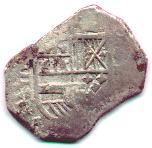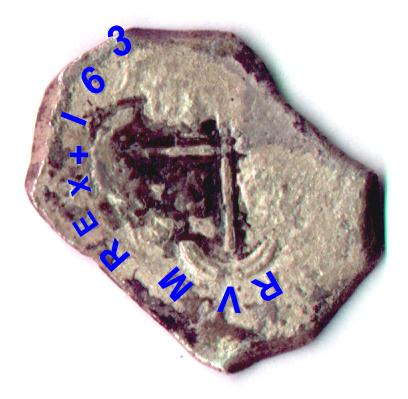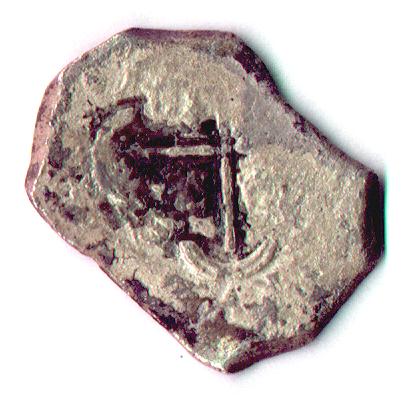
| #1822:
4 Reales 163(3), E, Cartagena. 11.112 grams / gramos.
| |
Obverse: Habsburg shield with Castile and Leon in correct order. Mint mark "C" to the right of the shield. Reverse: Cross with castles and lions. R/L M36-4, L/R M36C-4, C&T Type 117c, no. 617c. Anverso: Escudo de Habsburgo con castillos y leones en orden correcta. A la derecha del escudo está la marca de ceca "C". Reverso: Cruz rodeada por octolobo con castillos y leones en los cuarteles. R/L R/L M36-4, L/R M36C-4, C&T Tipo 117c, núm 617c. |
|
|
Calicó, R/L and L/R all illustrate the same coin, however it is not the same coin as #1822. L/R uses a reconstructed image so for comparison purposes we use the R/L and Calicó image. Struck from the same obverse die as the Calicó coin, we date the piece 1633 even though the reverse is so corroded on this piece that the date is barely distinguishable and the final digit is off the flan. What is very interesting is is that the images in R/L & Calicó show what appears to be an "N" situated between the "C" and the "E" in a vertical arrangement to the right of the shield. That would make it "C N E", instead of "CE". This could be possible, because there are coins with "RNE", all the die sinker would have needed to do would be to change the "R" to "C", instead of the "RN" to "C", if that is the case then the date of 1633 is quite logical. This issue needs more study, but until another coin appears the subject is inconclusive. |
|
|
Tanto Calicó como R/L y L/R ilustran el mismo espécimen, que no es igual a la #1822. L/R utiliza una imagen reconstruida así que para hacer comparaciones preferimos usar las imágenes de R/L y de Calicó. Fechamos la pieza 1633 a pesar de que el reverso está tan corroído que a duras penas permite reconocer la fecha y el dígito final quedó fuera del cospel, porque fue acuñado con el mismo troquel del anverso de la de Calicó. Lo que es muy interesante es que en los fotos de R/L y de Calicó, parece haber una N entre la C y la R, colocadas verticalmente a la derecha del escudo que quedaría, "C N E" en lugar de "C E". Esto es muy posible porque existen piezas "R N E" así el tallador todo lo que tenía que hacer era cambiar la "R", en lugar de "R N", por una "C". Siendo esto así, la fecha 1633 es perfectamente lógica. Este tema necesita más estudio. Pero mientras aparece otro ejemplar no se puede llegar a algo definitivo. |
|
|
|
Illustrated at the left is the reverse of #1822. Se ilustra en la izquierda el reverso de # 1822. |





